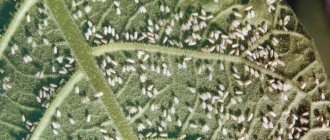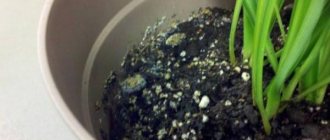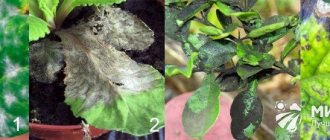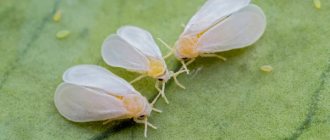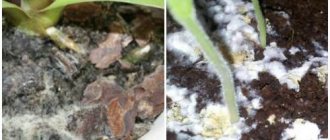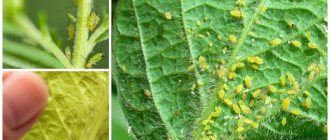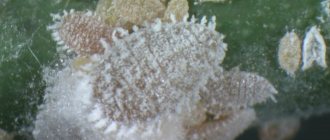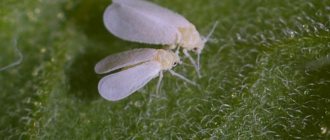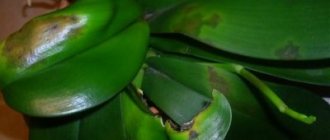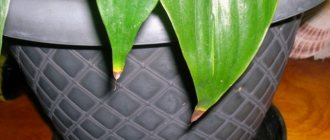- August 22, 2018
- Diseases and pests
- Legina Marina
If a sticky coating appears on your plants, then you need to immediately inspect the bottom of each leaf. The fact is that such symptoms very often indicate the presence of scale insects. Unlike most small pests, it is clearly visible on the surface of the leaf blade. It is the scale insect that is different in that it secretes a sticky liquid that seals the stomata and prevents the plant from breathing. At the same time, this film is an excellent breeding ground for fungi and bacteria. Today we’ll talk about what to do with scale insects on indoor plants and how to fight them. The photo will help you quickly identify this pest and select adequate control methods.
general description
What does this insect look like? This is a tiny creature that can destroy even a large tree. Its body is covered with a dense protective shell, so the scale insects can be mistaken for hard growths on the plant. It’s not for nothing that scale insects have a second name – garden turtle. But they are not at all as harmless as they might seem at first glance. In a couple of weeks, the voracious creatures will destroy any plant.
Every gardener should know well what scale insects look like on indoor plants and how to fight them. The photo shows us females up to 5 mm in length. They are the ones that are found motionless on plants and look like droplets of frozen resin. Males do not grow more than 3 mm and move freely around plants using legs or wings.
Reproduction and life activity
Scale insects live in colonies, which is why they can cause significant damage to the plant. They “suck out” all the useful substances necessary for growth, development and photosynthesis. Scale insects reproduce by laying eggs, from which larvae subsequently emerge . They spread throughout the plant and are localized in small groups. This can be noticed by the appearance of unusual growths and curvatures on the trunk.
Significant damage is:
- drying of shoots;
- yellowing and falling of leaves.
Usually there are one or two generations (offspring) per year. But at one time the female lays about 3000 eggs. As for life expectancy, for males it is only from 1 to 3 days, and for females it is months. But the males have wings, they can fly to different parts of the plant, and even move independently over long distances.
The full development cycle of an insect is 45-65 days. Having destroyed 1 generation, you no longer have to worry about this pest.
Reason for appearance
In the garden everything is clear: young females and males fly freely and cover considerable distances. How does scale insect appear on indoor plants? How to fight? We will look at photos of effective drugs below, but for now we will look at ways of penetration into your home. This is usually soil, plant debris and water. And most often, parasites come to your house with new plants.
They usually begin to fight them when they appear en masse, without previously noticing them. Therefore, a new generation of scale insects spreads into neighboring pots. And only sudden, massive shedding of leaves, inhibition of growth or death of plants can become a signal for the owner that it is time to show maximum care.
Why doesn't the Decembrist grow?
Schlumbergera may not grow due to several factors: insufficient feeding with mineral complexes or drying out of the substrate. During the growth period - from late March to August - it is necessary to fertilize with nitrogen and phosphorus, provide access to fresh air, cover from direct sunlight and do not forget about constant watering, spraying and washing with soft warm water. If the Decembrist dries out, the first thing to do is take cuttings and root again. Did you know? The life expectancy of zygocactus with proper care is very high - from 20 to 30 years.
Threatened
Scale insects can appear on indoor plants no matter how well you care for them. Moreover, it affects any plant, including succulents. But this pest also has its favorites, which are attacked first. We are talking about orchids and laurels. Palm trees and ivy do not avoid scale insects. With great pleasure, the scale insect feasts on Cyperus, Aucuba and other exotics. The usual household inhabitants are also under attack: chlorophytums, geraniums and hippeastrums.
What is noteworthy is that the pest most often appears in winter and early spring. This is evidenced by numerous amateur photos. How to deal with scale insects on indoor plants? It is necessary to improve the immunity of the plantings. After all, at this time the plants are most weakened, which becomes a decisive factor for the pest. It is much easier for them to harm flowers that are not able to resist. Therefore, follow the recommended conditions, and closer to spring add special immunostimulants to the soil. This could be inexpensive succinic acid.
Which indoor plants and flowers are susceptible to infection?
Scale insects can be found on almost any house plant: from bromeliads to Decembrist:
- The most “delicious” for brown scale insects are orchids and decorative laurels. Then ficuses, including ficus benjamina, palm trees, dracaenas, oleanders.
- Cactus scale insects can be found on cacti and succulents.
- The palm scale insect primarily affects young, tender leaves of palm trees. She is also a frequent visitor to dracaena, yucca, orchids, and tropical exotics.
- The olive scale insect lives on fat plants, citruses, oleanders, and hibiscus.
On an orchid
Damage caused
The larvae wait in the wings, feeding on cell sap. With severe damage, plants become covered with a coating of pest bodies, and it is almost impossible not to notice this. Autumn is coming in your home garden, the leaves are flying away.
The scale insect and its larvae can live and feed on indoor plants all year round, and the insects reproduce very quickly. They reproduce by laying eggs, which contributes to rapid population growth. At the initial stage, the larvae are very mobile, especially the males. But they live only a few days, and the female will feed and breed for several months.
What is the danger
The insect spoils the green mass, trunks, and causes tissue pathologies. Females cling with a developed piercing proboscis and absorb plant sap. Adult females and larvae are harmful - they suck the root system, branches, leaves, leading the plant to death.
Typical damage:
• false scale insects suck out the juice and replace the voids with poison. Toxins impair photosynthesis, the plates become covered with spots of yellow, yellow-brown color. The defect spreads quickly, the leaves die;
• The scale insect does not produce poison, but honeydew. The sweet secretion accumulates dust, attracts ants, and becomes a source of fungal and viral infections. A dark, moldy coating appears on diseased leaves. It blocks photosynthesis, preventing sunlight from reaching the plates.
Growths develop intensively - stems and foliage are covered with rounded plaques of brown, yellow or green shades. There is curvature of healthy tissues caused by cell hypertrophy.
The plant weakens, the green mass withers, turns yellow, and falls off. Blooming specimens change shape and color of flowers. Gradually, necrosis of the trunk occurs. With severe infection, all parts die.
Peculiarity! Scale insects secrete a sugary secretion on which saprophytic fungi settle. Gradually, niello and honeydew form. The decorative appearance, development and growth processes are disrupted.
The insect migrates quickly. The larvae crawl to the sides, rarely remaining on the mother flower. They find areas convenient for sucking, fixate, feed, and grow.
Do not confuse with false scale insects
This is another pest that appears very similar in appearance. These insects belong to the same order, but they are separated into a separate family. They differ from scale insects in that the latter do not have a waxy shell. Their eggs and larvae are protected by the dry skin of the dying female after laying. In the first stages, small insects move quickly, and this applies to both true and false scale insects. But if you see that a sticky patch begins to form on the leaves, there is no longer any doubt: this is what you are looking at.
General information
The scale insect is a representative of the Hemiptera family, part of the order Pseudococcida. The pest got its name because of the waxy shell that covers its body . This shell can be easily separated: only the unprotected body of the parasite will remain. There are several varieties of scale insects.
REFERENCE! The average length of individuals is 5 mm; larger ones are also found (usually females). Males are active, they can fly, but live no more than 3 days. Females lay eggs, protect the larvae and live up to 4 months.
After hatching, the larvae are mobile, they are in search of food . Later, the individuals attach themselves to one place and begin to drink plant juice. A protective wax shell also appears over time. Scale insects prefer garden plants; indoor plants are less likely to be affected. Most often, the parasite attacks citrus fruits, bromeliads, and palm crops. The pest also feeds on the juices of poisonous plants.
Preventive actions
Below we will talk about how to deal with scale insects on indoor plants, but for now let’s look at what can be done to prevent damage. The following measures will help protect your flowers:
- Constant control of the soil in plant pots. It must be of high quality and clean.
- Dead and weak shoots must be cut off in a timely manner. This will preserve the strength of the plant and prevent rotting. Be sure to disinfect the sections.
- Ventilate the room frequently and maintain the required air humidity.
- Quarantine all new plants for a month. A similar technique should be used when returning your plants from their summer residence in the garden, in the fresh air. There are quite a lot of chances to become infected with scale insects in the garden.
Prevention
You can protect plants from pest attack by regularly ventilating the premises and maintaining a balance of light and water. When purchasing new plants, it is important to adhere to quarantine: keep them separately for 2-4 days.
Important rules for florists and gardeners:
- Carefully check the leaves regularly for signs of parasites or traces of their presence.
- Before contacting plants, be sure to wash your hands, as scale insects can be transferred to them.
- Wash the leaves under running water more often (the scale insect does not like moisture), the soil must be covered while doing this.
- Do not place the flower in the open sun, this can only harm it. It is enough to just choose a warm place.
Scale insects are a dangerous pest for garden and indoor plants , but with timely detection, you can avoid losses. Carry out preventive measures regularly, do not forget about the general rules of care: watering, fertilizing, strengthening the root system.
Fighting methods
The more pests manage to multiply, the more difficult it will be to get rid of them, and the more severe the damage caused. And the first remedy for scale insects on indoor plants is to pick them from the leaves by hand. It should be noted that the fight against these creatures is long and very difficult. A durable shell reliably protects pests from any damage. Therefore, first of all, we examine the axils and leaves on both sides. A small flat growth is a pest. It must be carefully torn from the plant and destroyed. To make this task easier, you can use a toothbrush. This is only the first, but a very important step. Because by leaving pests on the stems, you give them a chance to reproduce.
Why does the Decembrist shed its buds?
The flower drops its buds - as a rule, mites are to blame for this. If a spider mite caused damage, then the fallen leaves should have a yellow base with rusty-brown spots. Look carefully. If there are no mites or signs of them, slightly shake the Decembrist from side to side, it may have problems with the roots.
The root system is the weakest part of the Decembrist, it easily rots and dies off at the slightest mistake during care. If the plant wobbles, then it must be urgently transplanted into new soil and into a clean, disinfected old pot or into a new one.
All bad, acidic soil and affected roots are removed. Rinse the roots well under running warm water (40 - 50 degrees) to make sure they are in order.
It is a misconception that Decembrist loses leaves and flowers from lack of moisture. Therefore, they mistakenly begin to increase watering. The flower will begin to wither rather than shed its segments.
Hygiene measures
The fight against scale insects on indoor plants begins with treatment with a soap solution. Most pests cannot tolerate this. Moreover, both the placement of the pots and the vessels themselves will need to be treated. It is best to replace the soil by first calcining the fresh soil mixture.
To prepare a concentrated soap solution you will need 100 g of grated laundry soap and a liter of water. After complete dissolution, add 200 ml of kerosene. All this must be thoroughly mixed until a white foam forms. Before use, the mixture must be diluted in 10 liters of water. After wiping with this solution, the plant is given a warm shower a few hours later, after which it is placed in a warm place to dry. This is one of the gentlest remedies, but it can be quite effective. True, there is a chance that the larvae will survive and give birth again. For complete victory, 2 to 3 treatments may be required at intervals of 7 days. The fight against scale insects on indoor plants can be long and difficult, so let's look at more reliable means.
How to detect scale insects
Not many gardeners, especially beginners, manage to immediately detect the pest, and this is precisely the main reason for its spread. Usually people panic only when they begin to observe massive falling of leaves and wilting of plants.
However, there are several ways in which you can identify a pest and below you can familiarize yourself with them:
- Pay attention to the veins along the leaves. If you find strange convex round bumps or plaques on them, then know that this is a scale insect that needs to be dealt with urgently. Do not pay attention to the color of such tubercles, because in scale insects their shells can take on different shades.
- In the initial stages of appearance, the scale insect is almost impossible to identify due to its small size and camouflage methods. But due to their vital activity, they secrete sticky mucus that covers the leaves. Please note that if the leaves of your plant are sticky, then it is likely that you need to sound the alarm.
- Over time, red spots may appear on the leaves and stems and increase in size. If you also notice tubercles, then most likely your plant has been attacked by a scale insect.
- In later stages, pay attention to the early wilting of the leaves, deformation of the stem and their gradual drying. Inspect the plant, and if you find other signs of a pest attack, you will need to take immediate action.
- Falling of flowers and fruits and growth cessation is the extreme degree of pest damage to a plant. If you observe something like this, then know that by this moment the chance of saving the plant will be 50/50, but it’s worth a try in any case.
It is noteworthy that the scale insect can return to the plant it loves, so treatment must be carried out over a long period of time, preventative work must be constantly carried out, and the plant must also be constantly inspected. Because the reappearance of scale insects will also threaten you with sooty fungus, which will have to be treated separately.
Traditional methods
So, we cleaned the plant from pests with a toothbrush, washed it with soapy water and dried it well. Now we consider further how to deal with scale insects on indoor plants using available means:
- Garlic solution gives good results. To do this, add 5 crushed cloves to a glass of water and leave in a dark place. After this, strain through cheesecloth and spray the plant with the solution. You need to carry out a number of treatments to get a good result.
- Pepper infusion. Another advantage is that the solution can be prepared for future use. To do this, boil 50 g of pepper for 5 minutes in 500 g of water. Let it sit for 24 hours and the infusion is ready.
- Celandine. Almost all pests cannot tolerate it. You will need to pour 300 g of dry celandine herb with a liter of boiling water. Leave for 24 hours, then spray the diseased plant.
- Oil film. Insects are living creatures that require air. To block its access, you can lubricate the affected areas with sunflower oil using a brush. The procedure is repeated every day until the insects completely disappear.
The effectiveness of folk remedies is quite difficult to assess. They are safe for humans, which is a big plus. But often gardeners are faced with the fact that the result is temporary and comparable to manual collection of pests. Within a few days, the larva hatches, and the surviving individuals lay new eggs. And now a new generation of pests is destroying your flowers. Of course, on a garden scale it is more difficult to deal with them. But if you have 3 - 5 pots at home, then you can check every leaf every day and not give the pest a single chance.
How to recognize a pest?
Scale insects are insects no larger than 5 mm in size. There are numerous tentacles on their body, with the help of which they are attached to the surface of leaves and stems. The integument is translucent and looks like a waxy plate. And if such individuals were found on indoor plants, then this means that you are looking at none other than the scale insect - a pest, the fight against which is often quite difficult.
And the main difficulty in destroying these parasites is that young individuals do not yet have a sticky shell, and therefore are able to move freely throughout the plant’s body and move to neighboring specimens. Plus, male scale insects have wings, thanks to which they can fly up to several meters. For these reasons, absolutely all flowers from your home collection should be processed.
However, while adults are quite easy to spot, their eggs are so tiny that it is very difficult to recognize them with the naked eye. In addition, females always lay their clutches on the underside of leaf blades or in those places where the leaves are attached to the stem.
By sucking juices from plants, scale insects deprive them of nutrients, as a result of which the flowers lose significant reserves of vitality. Affected specimens begin to gradually fade, their growth and development are inhibited. At this time, voracious parasites move onto the foliage and continue to spoil the plant. Young shoots that have not yet gained enough energy and strength suffer the most from scale insects. They die very quickly.
One colony of scale insects can completely destroy an adult plant about half a meter high in just two weeks. As a result of the invasion of parasites, only a bare, dry stem will remain from a two- to three-year-old flower. And it will no longer be possible to save him.
On a note! When a plant loses 2/3 of its foliage, it cannot be resuscitated!
Therefore, the home greenhouse must be regularly inspected and, if scale insects are detected, act immediately by selecting the correct control methods.
We use insecticides
A photo of a scale insect on indoor plants makes it clear that it can cause serious damage to any flower, even to the point of its complete death. Therefore, at the first sign of defeat, you need to get down to business. And the most effective way of control is the use of insecticides, that is, treatment with chemicals. But here, too, there is no guarantee that you will get by with just one treatment, because combating this pest requires a systematic approach. The choice of drugs today is quite large. But the most effective can be considered those that are designed to combat dipterous insects, including the Colorado potato beetle.
Where does the pest come from on house flowers?
They can be very different. The plant may have already been sold as infected. Then the methods of control depend only on how highly developed the pest is and how much damage it has already caused.
- Scale insect larvae can be carried by the wind, fly onto a balcony or through an open window. Or the infection could have occurred in a summer cottage.
- If a plant is grown in unsuitable conditions for it (too hot, humid, cold, insufficient nutrition, etc.), it also contributes to the appearance of parasites and diseases.
- If a flower is “overfed,” especially with nitrogen, this significantly weakens its immunity.
"Aktara"
If you have tried traditional methods and are still looking for options on how to get rid of scale insects on indoor plants, then it’s time to move on to more radical measures. This drug affects the nervous system of insect pests, causing paralysis of the respiratory and nervous systems. The product is available in ampoules, which is very convenient.
This product destroys plant-feeding insects at all stages. The drug works equally well when applied to the leaves and watered at the root. That is, it accumulates in the vegetative parts of the plant, which makes it resistant to precipitation.
Signs of scale insect infestation
At the site where the parasite suctioned (after its death), you can notice a small hole, the tissue around which is dead. You can also see the attached insects themselves; they look like small bulges, dark-colored tubercles. The main signs that scale insects have settled on flowers are the following:
- Leaves and shoots begin to dry out and fall off.
- Plant growth slows down, shoots shorten, bend, buds do not set or fall off.
- The plant, especially the leaf blades, is covered with a sticky coating (honeydew).
- In the case of massive damage, on the stem, shoots, and leaves, you can see with the naked eye a cluster of insects, similar to a continuous bumpy crust.
"Aktellik"
And we continue to talk about how to fight scale insects on plants. "Actellik" is a popular insecticide that allows you to quickly deal with garden parasites. The drug "Actellik" CE, that is, a concentrated emulsion packaged in ampoules of 2 ml, contains the active ingredient pirimiphos-methyl. It can affect the pest in the following ways:
- Through outer shells.
- Through the digestive organs.
- through the respiratory tract.
The emulsion is widely used for indoor plants. It is non-toxic to people and pets when used correctly. Today this is one of the best means to combat scale insects.
All about the Decembrist flower
The flowering of the Decembrist is remembered for a long time, because its flowers have an unforgettable long-tubular multi-tiered shape. A bunch of rather long stamens hanging from the middle of a symmetrical flower gives it a spectacular and original look. In its natural environment, pollination of the plant occurs with the help of hummingbirds. Schlumbergera blooms in mid-summer, which in South America begins at the same time as winter begins in the Northern Hemisphere. This is precisely the reason why the plant is called Decembrist. Red and white flowers appear at the very tips of the stems. Over time, various varieties of plants have been developed, which can be either pink, yellow and white, or purple or crimson.
We recommend reading these articles:
Treatment of trees in the spring during bud break
Treatment of shrubs in the spring during bud break
Treating shrubs in the spring against pests and diseases with Bordeaux mixture
A rather unusual root system in natural conditions is accustomed to adapt to the difficult Brazilian forests. The fact is that in the tropics the necessary layer of soil is practically absent, so the roots of the Decembrist are weak, which can die very quickly. But at this moment, the so-called search roots come to the aid of the plant, which are capable of developing into full-fledged roots in the shortest possible time. In addition, they can transform into aerial roots (as in some varieties of Ficus Benjamin), which the bush needs to be saturated with oxygen and sufficient moisture.
Varvarin color differs from other cacti in that it grows very quickly. This is due to the fact that in the natural environment, having found itself in an environment that is most suitable for it, the plant wants to occupy as much space as possible, which will allow it to avoid meeting any competitors. This flower also produces abundant, unforgettable blooms, reproduces without much difficulty and can take root as quickly as possible, which allows it to keep other plants away from it.
"Fitoverm"
Experienced gardeners are well acquainted with this drug. It perfectly helps to cope with a wide variety of pests of both garden and potted plants. The drug must be diluted in a proportion of 1 ml per 200 ml of water. Fitoverm is not a highly toxic drug for humans and does not carry the risk of serious poisoning. This is one of its important advantages, along with its high efficiency in the fight against parasites. This is especially important since the drug is used in a residential area where other family members are located.
Chemicals for scale insects
Today, preparations to combat scale insects can be purchased at almost any flower shop. Among the most popular:
- "Aktellik" is a highly effective product that is used for spraying affected plants and watering the substrate. Shows excellent results both in the treatment of indoor flowers and in the destruction of scale insects in warehouses. To prepare the working fluid, 2 ml of the drug is mixed with a liter of water and immediately used for processing. First, the entire body of the plant is generously moistened, and the remainder is poured onto the root system and substrate. The speed at which the product works will depend on the viability of the parasite and environmental conditions. How quickly the effect will be visible depends on these same factors. Actellik provides reliable plant protection for two to three weeks. Among its advantages: prevention of re-infestation, compatibility with other chemicals, which guarantees a positive effect, and the ability to use it for processing planting material, in particular seeds. However, it has an unpleasant odor, it is highly not recommended for use in residential areas, and due to its toxicity, it can be dangerous to the health of people, especially children, and pets.
- “Aktara” is used to protect plants from various kinds of parasites, including scale insects. Like the previous product, it can be used for spraying and shedding the soil. However, it is better to saturate the soil with most of the working fluid. In this case, the active substances will be properly absorbed into the plant’s body and, when the pests feast on its juices, they are guaranteed to die after some time. Since the drug "Aktara" is allowed for use both in open ground conditions and for treating flowers directly in the apartment, it should be diluted correctly, and for each specific case there is its own dosage: for scale insects in residential premises - 1 ml of the product per 1 liter of water , for processing flowers in open ground conditions - 4 g of dry matter per 1 liter of water, then the resulting solution is diluted in a sprayer tank (600 ml of solution per ¼ tank of water), for spraying trees and currant bushes - 4 g of dry matter per 1 liter of water , then the resulting solution is diluted in the sprayer tank (250 ml of solution per ¼ tank of water). 24 hours after treatment, the pests die. This drug can be used in combination with growth stimulants. However, remember that it is toxic to bees and other insects involved in plant pollination.
- "Bankol" is one of the best drugs against scale insects, which is used to protect indoor flowers. It exhibits contact activity and, when it gets on the body of the parasite, paralyzes its nervous system. Within two or three days he dies. To treat flowers, 0.5 g of the drug is dissolved in a liter of water. "Bankol" is characterized by low toxicity, continues to be effective even after rain and is odorless. However, in order for the product to be guaranteed to give a positive result, it is advisable to use it at high thermometer readings.
- “Fitoverm” is a biological acaricide that works well against a whole range of parasites of house plants, including scale insects. In order to make a working solution, 2 ml of the drug must be diluted in half a liter of water. The prepared liquid is sprayed onto infected specimens. The main advantage of Fitoverm is that it is the least toxic compared to the above chemicals. However, this will require a greater number of treatments.
Rules for the use of chemicals
Chemicals are quite effective in combating scale insects and provide long-term prevention of their reappearance. However, please note that:
- these products have a certain degree of toxicity, and therefore it is necessary to work with them with extreme caution and carefully read the instructions;
- if there are animals or children in the house, then at the time of processing the plants they should be removed from the room;
- You cannot use the same remedy often, since otherwise the parasites will develop immunity - drugs, and more precisely, the active substances on which they are based, it is advisable to constantly change.
"Fufanon"
This is the most popular drug used to treat cultivated and ornamental plants. Even in the garden he is able to remain active for two weeks. And if we talk about greenhouses and house plants, then the drug will retain its original concentration for up to a month. This is a huge plus, since you will not have to repeat the treatment after the larvae hatch. There is enough time to destroy all generations. With the help of this drug, the fight against scale insects on indoor plants becomes quite simple.
Its active substance malathion is highly toxic. This is a contact drug that has an effect on parasites upon direct contact with their bodies, respiratory and digestive organs. Of course, extreme care must be taken to ensure that pets and fish, as well as family members, are not harmed during processing.
